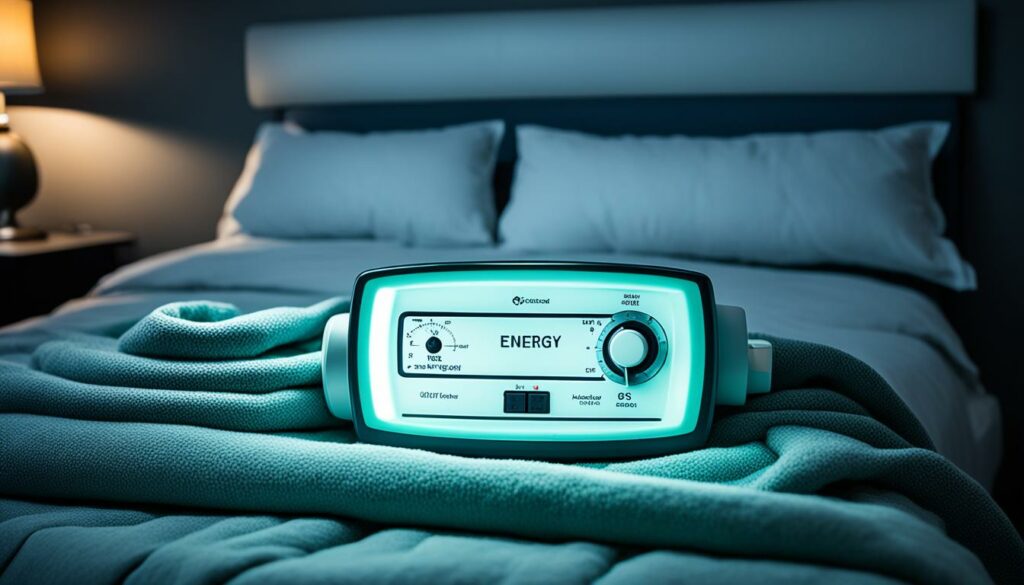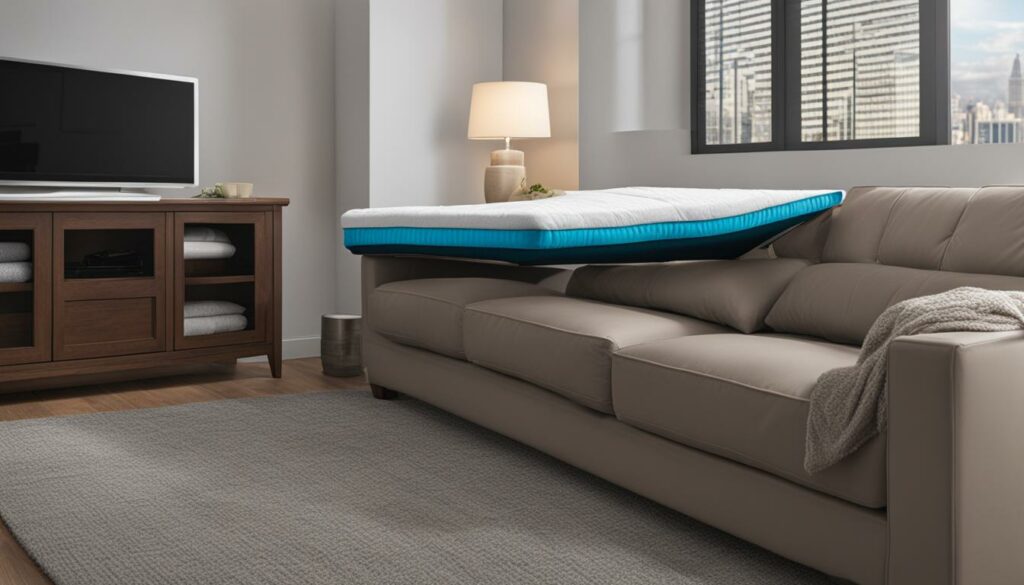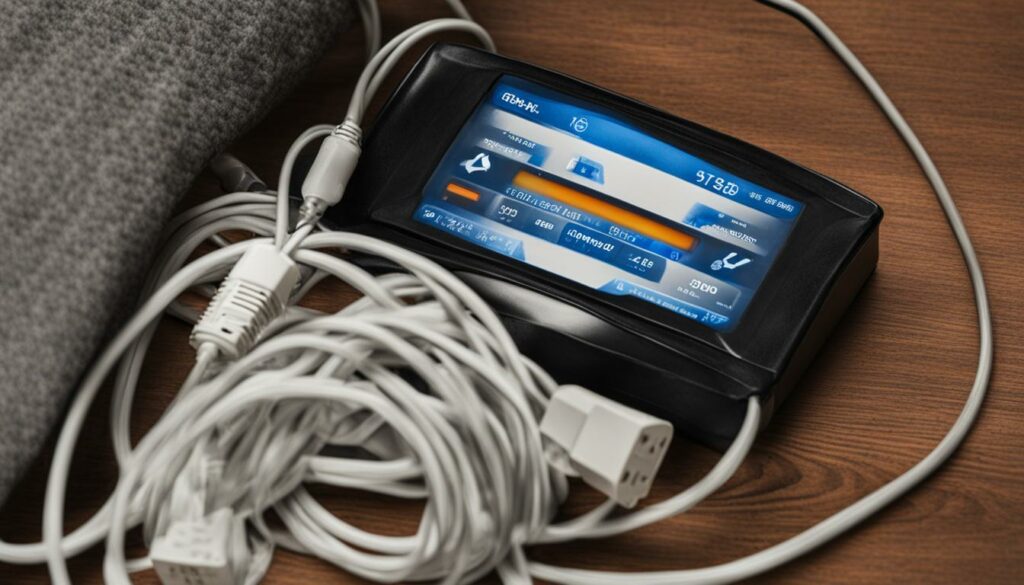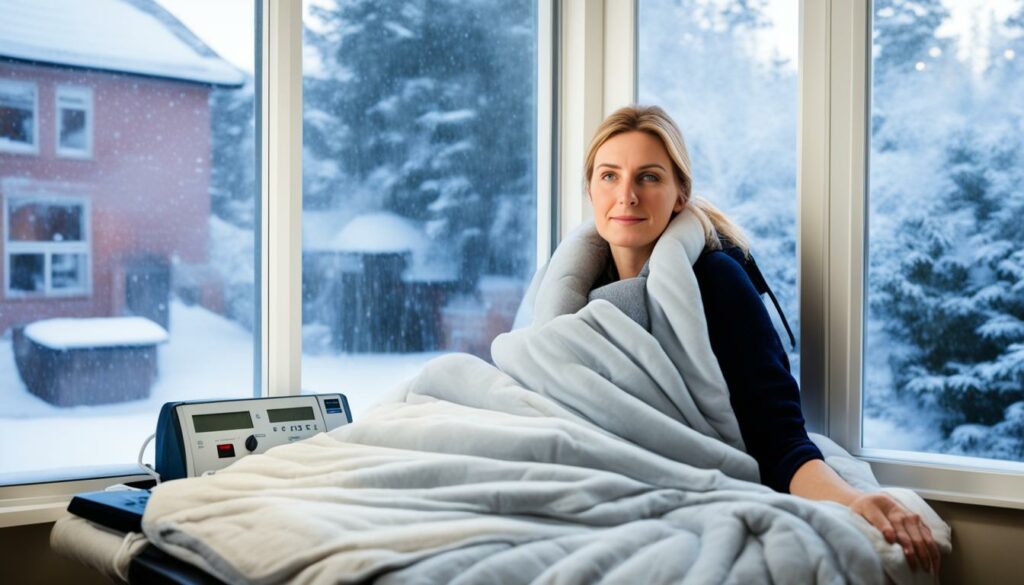Electric Blanket Power Use Explained – Save or Splurge?
Eric Christie stands as a luminary in the bedding industry, with a career spanning nearly four decades since the early 1980s. His journey through the world of bedding has seen him wear many hats – a manufacturer, designer, and retailer, showcasing his versatility and expertise in Read more...
pillowsandbedsheets.com and its partners may earn a commission if you purchase a product through one of our links
Are you considering investing in an electric blanket but unsure about its power consumption? Wondering if it’s a smart choice for saving on electricity bills? In this article, we’ll delve into the power use of electric blankets, helping you make an informed decision whether to save or splurge on this cozy home accessory.
Key Takeaways:
- Electric blankets work by generating heat using internal wiring.
- The power consumption of electric blankets is measured in watts.
- Most electric blankets have power ratings ranging from 100 to 300 watts.
- Understanding the power metrics of electric blankets can help you choose a blanket that suits your energy needs and preferences.
- Using an electric blanket with proper insulation and other energy-saving measures can help save on heating costs.
How Much Electricity Do Heating Blankets Use?
The amount of electricity used by heating blankets depends on their wattage rating and duration of use. For example, a 150-watt electric blanket used for 2 hours each night would consume approximately 0.3 kWh of energy.
To better understand the electricity usage of heating blankets, let’s take a look at the breakdown:
| Electric Blanket Power Rating | Usage Duration | Energy Consumption | Cost Calculation |
|---|---|---|---|
| 150 watts | 2 hours | 0.3 kWh | $0.036 per day | $10.80 per month |
Based on average electricity rates, the estimated cost of running a 150-watt electric blanket would be $0.036 per day or $10.80 per month.
To put it into perspective, the cost of running an electric blanket is significantly lower compared to other household electrical appliances. Plus, using an EcoFlow DELTA 2 Max portable power station can further minimize operating costs for off-grid use.
While the electricity consumption of heating blankets may vary depending on the wattage and duration of use, it is generally considered relatively low and affordable for most users.
Note: The cost calculations are based on average electricity rates and may vary depending on your location and utility provider.
https://www.youtube.com/watch?v=TT7hcRCftWY
Energy Efficiency of Heating Blankets
When considering the energy efficiency of heating blankets, several factors come into play. Room insulation, blanket materials, and individual needs can all impact the optimal wattage level for achieving desired warmth.
Well-insulated rooms may require lower wattage blankets, while individuals who are more sensitive to cold may prefer higher wattage options.
It’s important to check the specifications of electric blankets for voltage, amperage, and wattage ratings to ensure safe and efficient use.
By choosing a blanket that matches the voltage supplied by household outlets and using it judiciously, users can minimize electrical costs and maximize energy efficiency.
For a better understanding of energy consumption comparison, refer to the table below:
| Blanket Type | Average Wattage | Cost per Month* |
|---|---|---|
| Standard Electric Blanket | 150 watts | $10.80 |
| Dual Control Electric Blanket | 200 watts | $14.40 |
| Low-Voltage Electric Blanket | 80 watts | $5.76 |
*Based on an average electricity rate of $0.12/kWh.
As you can see, the cost of using heating blankets varies depending on their wattage. Choosing a more energy-efficient blanket can help reduce your monthly electrical costs without compromising comfort.

Electric Blankets vs. Other Heating Methods
Compared to other heating methods, electric blankets can be a cost-effective and energy-efficient option. For example, the annual cost of using an electric blanket for preheating a bed is relatively low, especially when compared to the energy consumption of electric heating in an apartment. Electric blankets provide targeted warmth to specific areas, allowing you to reduce the amount of time your main heating source is in use.
By using an electric blanket for limited durations and preheating your bed, you can effectively save on heating costs. Additionally, electric blankets require minimal maintenance and can be a long-term, cost-effective heating solution.
Energy Consumption Comparison
To better understand the energy consumption of heating blankets in comparison to other heating methods, let’s take a look at the following table:
| Heating Method | Energy Consumption |
|---|---|
| Electric Blanket | Low power consumption, typically around 150-300 watts. |
| Electric Heater | High power consumption, typically ranging from 750 to 1500 watts. |
| Central Heating | Significant energy consumption, heating the entire home even when specific areas don’t require heat. |
As you can see, electric blankets consume considerably less energy compared to electric heaters and central heating systems. This makes them a more energy-efficient option, especially when you only need heating in a localized area.
Using an electric blanket as a supplemental heating source can help reduce your energy consumption and lower your heating costs. By focusing heat directly on your bed or specific areas, you can avoid wasting energy on heating unoccupied spaces within your home.
Furthermore, electric blankets offer the advantage of customization and flexibility. You have the ability to control the warmth according to your preferences, without the need to turn up the thermostat for the entire house.
It’s important to note that when using any heating method, including electric blankets, it’s essential to consider safety guidelines and adhere to manufacturer’s instructions to ensure proper and safe operation.

Safety Tips for Using Electric Blankets
While electric blankets are designed with safety features to prevent overheating, shocks, and fires, it’s crucial to follow manufacturer’s instructions and take necessary precautions to ensure safe use. By following these safety tips, you can enjoy the warmth of electric blankets while minimizing potential risks:
1. Voltage Rating:
Make sure to check the voltage rating of your electric blanket and avoid exceeding it. Exceeding the recommended voltage can lead to overheating or electrical issues.
2. Inspect for Damage:
Regularly inspect your electric blanket for any signs of damage, such as frayed wires or worn-out fabric. If you notice any damage, stop using the blanket and consider replacing it.
3. Avoid Overheating:
It’s important to avoid overheating your electric blanket. Follow the recommended temperature settings and avoid folding or tucking the blanket in a way that restricts airflow, as it can lead to overheating.
4. Timer or Automatic Shutoff:
Consider using a timer or electric blanket with an automatic shutoff feature. This will provide an added layer of safety and ensure that the blanket doesn’t remain on for extended periods while you sleep or are away from the bed.
5. Replace Old or Worn-out Blankets:
Over time, electric blankets may deteriorate, and their safety features may become less effective. It’s recommended to replace old or worn-out electric blankets to maintain optimal safety and performance.
To further enhance the safety of your electric blanket, consider using the EcoFlow DELTA 2 Max portable power station. This power station provides a steady and clean electricity supply, ensuring the safe operation of your electric blanket.
By taking these safety precautions and regularly checking your electric blanket for any issues, you can enjoy the warmth and comfort it provides without compromising on safety.
| Safety Tip | Description |
|---|---|
| Voltage Rating | Ensure you don’t exceed the recommended voltage rating of the electric blanket. |
| Inspect for Damage | Regularly check for signs of damage and replace the blanket if necessary. |
| Avoid Overheating | Follow temperature settings and avoid blocking airflow to prevent overheating. |
| Timer or Automatic Shutoff | Use a timer or blanket with automatic shutoff for added safety. |
| Replace Old or Worn-out Blankets | Replace old or worn-out blankets to maintain safety and performance. |
Electric Blankets: Worth the Investment?
When considering the cost of running an electric blanket, it’s important to factor in its wattage, hours of use, and electricity rate. While there may be an upfront investment involved in purchasing an electric blanket, it can prove to be a worthwhile one for several reasons.
One of the key benefits of electric blankets is their ability to save on heating costs. By pre-warming the bed with an electric blanket, you can reduce your reliance on the main heating source, resulting in potential energy savings. This targeted heating approach allows you to customize your warmth without having to heat the entire room, providing both convenience and flexibility.
Moreover, electric blankets are known for their energy-efficient performance. Compared to other heating appliances, they consume relatively low amounts of electricity, making them an eco-friendly choice. With rising energy costs, investing in energy-efficient appliances like electric blankets can help save money in the long run and contribute to a greener lifestyle.
Aside from being cost-effective and energy-efficient, electric blankets also require minimal maintenance. Simply follow the manufacturer’s instructions for care and usage, and your electric blanket will continue providing cozy warmth season after season.
Is an Electric Blanket Worth the Investment?
“Investing in an energy-efficient electric blanket allows you to enjoy customized warmth, potential energy savings, and minimal maintenance.”
When weighing the cost of running an electric blanket against its benefits, it’s clear that the investment is worth it. Not only can an electric blanket provide cost-effective heating and potential energy savings, but it also offers a level of comfort and convenience that traditional heating methods may not provide.
Additionally, with the increasing focus on energy conservation and the use of energy-efficient appliances, electric blankets align perfectly with these goals. By investing in an energy-efficient electric blanket, you are making a smart choice for both your comfort and the environment.
Comparison of Electric Blankets with Other Heating Methods
Let’s compare the cost of running an electric blanket with the cost of other common heating methods:
| Heating Method | Energy Consumption | Cost per Hour* |
|---|---|---|
| Electric Blanket | 200 watts | $0.02 |
| Electric Heater | 1000-1500 watts | $0.10-$0.15 |
| Central Heating System | Varies depending on the system | Higher per hour* |
*Costs are approximate and based on average electricity rates in the United States.
As shown in the table above, electric blankets offer a cost-effective and energy-efficient heating option compared to other methods. With significantly lower energy consumption and lower costs per hour, using an electric blanket can help you save on heating expenses while still enjoying a cozy and warm bed.
Considering the benefits of cost savings, energy efficiency, and convenience, investing in an electric blanket is definitely worth it. Its ability to provide targeted warmth, potential energy savings, and minimal maintenance make it a smart choice for anyone looking for a cost-effective and energy-efficient heating solution.

Electric Blankets vs. Electric Heaters
When comparing electric blankets to electric heaters, it’s important to consider their efficiency and cost-effectiveness for targeted heating. Electric blankets are designed to provide warmth directly to the bed, sofa, or body, making them more efficient in terms of energy consumption. On average, electric blankets typically use around 200 watts per hour, resulting in a low run cost of approximately two cents per hour.
In contrast, electric heaters consume more electricity to generate heat and are designed to warm up an entire space. This often leads to higher energy consumption and increased costs. When heating an entire room, the electricity usage of electric heaters can be significantly higher compared to the targeted heating provided by electric blankets.
In order to achieve both warmth and cost savings, consider using an electric blanket in conjunction with an efficient space heater. This combination allows you to enjoy the direct warmth and energy efficiency of an electric blanket while efficiently heating larger areas of your home with the space heater. By strategically using these heating methods, you can create a comfortable and cost-effective environment.

If you’re concerned about the cost of running an electric heater and want to make a more energy-efficient choice for heating, utilizing an electric blanket can be a smart alternative. Not only does it provide direct warmth to your desired area, but it can also help reduce your overall heating costs. By using electric blankets and space heaters wisely, you can create a cozy and energy-efficient living space.
Comparison of Electric Blankets and Electric Heaters
| Factors | Electric Blankets | Electric Heaters |
|---|---|---|
| Targeted Heating | ✓ | – |
| Energy Consumption | Low | High |
| Run Cost per Hour | Approximately two cents | Higher than electric blankets |
| Usage | Direct heating for beds, sofas, or the body | Heating entire rooms or spaces |
| Cost-effectiveness | Cost-effective for targeted heating | May result in higher energy costs |
By considering the efficiency and cost-effectiveness of electric blankets in comparison to electric heaters, you can make an informed decision when choosing your heating methods. Electric blankets offer a focused and energy-efficient solution, allowing you to enjoy warmth while minimizing your energy consumption and costs.
Considerations and Conclusion
When choosing an electric blanket, there are several important factors to consider. First, pay attention to the wattage, voltage, and amperage of the blanket. These specifications will determine the level of heat the blanket can provide and whether it is compatible with your electrical outlets. Additionally, think about your individual heating needs and preferences. Some people may prefer a lower wattage blanket for milder warmth, while others may require a higher wattage option for extra coziness.
By selecting an electric blanket that matches your power requirements and using it efficiently, you can enjoy both affordable and targeted warmth. Electric blankets are a cost-effective and energy-efficient alternative to traditional heating methods. They allow you to concentrate warmth where you need it most, reducing overall energy consumption and saving on heating costs.
To maximize the energy efficiency of your electric blanket, it’s important to complement it with proper insulation and other energy-saving measures in your home. By ensuring your living space is well insulated, you can retain the heat generated by the blanket and keep energy usage to a minimum. Adhering to safety guidelines is also crucial to ensure a safe and comfortable experience with your electric blanket. Regularly check for any signs of damage, avoid exceeding the voltage specifications, and utilize timers or automatic shutoff features for added peace of mind.
In conclusion, electric blankets offer a practical and energy-conscious solution for staying warm during colder months. By carefully considering the specifications of the blanket, using it efficiently, and following safety guidelines, you can enjoy cozy nights without compromising energy efficiency or your budget.
FAQ
How much electricity do heating blankets use?
The electricity consumption of heating blankets depends on their wattage rating and duration of use. Most household electric blankets have power ratings ranging from 100 to 300 watts. For example, a 150-watt electric blanket used for 2 hours each night would consume approximately 0.3 kWh of energy.
Are heating blankets energy-efficient?
Heating blankets can be energy-efficient when used properly. Factors such as room insulation, blanket materials, and individual needs can impact the optimal wattage level. By choosing a blanket that matches the voltage supplied by household outlets and using it judiciously, users can minimize electrical costs and maximize energy efficiency.
How do electric blankets compare to other heating methods?
Electric blankets can be a cost-effective and energy-efficient option compared to other heating methods. They provide targeted warmth to specific areas, allowing users to reduce the amount of time their main heating source is in use. By using an electric blanket for limited durations and preheating the bed, consumers can effectively save on heating costs.
What are some safety tips for using electric blankets?
To ensure the safe use of electric blankets, it’s important to follow manufacturer’s instructions, avoid exceeding the voltage rating, and watch out for signs of damage or overheating. Using timers or automatic shutoff features and replacing old blankets are also recommended. The use of portable power stations can provide steady and clean electricity for safely running electric blankets.
Are electric blankets worth the investment?
Despite the upfront cost, electric blankets can be a worthwhile investment. They can help save on heating costs by pre-warming the bed and reducing the reliance on the main heating source. Electric blankets offer convenience and flexibility, allowing users to customize their warmth without heating an entire room. With minimal maintenance required, electric blankets provide a cost-effective long-term heating solution.
How do electric blankets compare to electric heaters in terms of efficiency and cost?
Electric blankets tend to be more efficient and cost-effective for targeted heating compared to electric heaters. Electric blankets typically use around 200 watts per hour, translating to a low run cost of approximately two cents per hour. Electric blankets provide heating directly to the bed, sofa, or body, whereas electric heaters heat an entire space. To achieve warmth and cost savings, using an electric blanket in conjunction with an efficient space heater can be a smart option.
What factors should be considered when choosing an electric blanket?
When considering electric blankets, factors such as wattage, voltage, and amperage should be taken into account. Individual heating needs and preferences, room insulation, and other energy-saving measures should also be considered. By choosing an electric blanket with the appropriate power rating and using it efficiently, users can enjoy affordable and targeted warmth.
Eric Christie stands as a luminary in the bedding industry, with a career spanning nearly four decades since the early 1980s. His journey through the world of bedding has seen him wear many hats – a manufacturer, designer, and retailer, showcasing his versatility and expertise in Read more...







